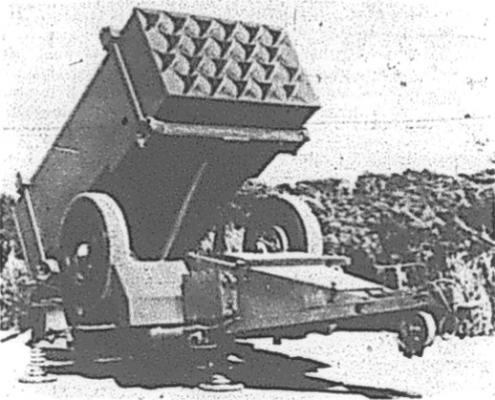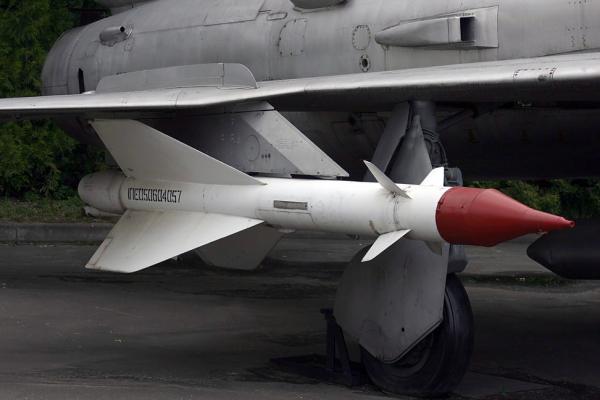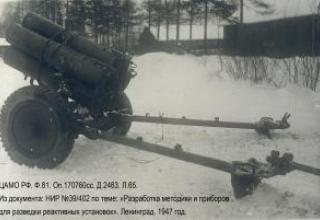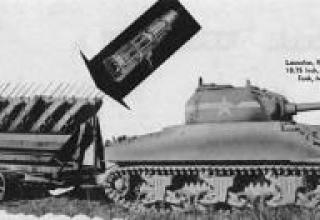The pilot rocket launcher RAP-14 has been developed since the late 1960s by the French company Constructions Navales et Industrielles de la Médterranée.
The design of the RAP-14 included a lightweight military trailer with hydro-pneumatic suspension on which an artillery unit with a replaceable package of rails was mounted. When the wheels of the trailer were lifted, the unit was supported by three hydraulic jacks, on the ends of which there were round plates (pancakes), ensuring the stability of the installation on soft ground. The installation was then horizontally and vertically oriented in the required direction. Guidance mechanisms were equipped with hydraulic and manual drives. The hydraulic drive was also used to unhook the unit from the tractor and move it from the camping position to the combat one (it took 2 minutes) and back. The source [3] indicated that the transfer of the unit from camping to combat position could be made by one number of calculation within one minute.
The time it took to charge the machine with two numbers of calculation was 10 minutes. The unit could also be charged in 1 minute by means of a cargo crane by replacing an empty pack of rails with an equipped one. The dimensions of the guideway package are 3200×1860×1250 mm.
Fastening of the guide package was ensured by means of a hydraulic locking and locking mechanism. The projectile slid on two grooves in the guide and at the same time rotated by means of a spiral plane (it is more likely that the guide design included two spiral guide grooves).
The 140mm RAP-14N rockets weighing 54kg and 2000mm long, with single-mode powder engine weighing 16kg and four-blade rigidly bonded, were used for firing. Operating time of the jet engine - 2s, NURS speed at the end of the active section of the trajectory - 680m/s, initial impulse - 3000N, maximum flight distance - 15700 m, circular probable deviation - 100m. The source [2] shows the projectile caliber - 138 mm.
The regular rocket projectile was equipped with a blasthead with an explosive charge weighing 5.5 kg. Shock or non-contact fuses were used to detonate the head end.
SAE Alsetex developed an 18 kg version of the 18 kg high-explosive head unit with a 4 kg explosive charge and 7,300 spherical striking elements (according to [1] the head unit weighed 19 kg). The fragmentation head unit may have been equipped with an impact or non-contact (electromagnetic) detonator.
Other types of head units were: lighting, ignition and smoke (smoke-smoking).
In the early 70s of the XX century, the NURS RAP-14S of 138 mm caliber was developed, with a maximum range of 20,000 meters.
Shots were fired by means of a remote fire control unit connected to the unit via a 40 meter long cable. The fire control unit consisted of a current distributor and a correction device. The current distributor checked 22 firing circuits, the choice of firing mode - single or multiple firing, as well as leading or stopping fire. The corrector provided for the detection and transmission to the wind of the corrections received from the gunshot projectile.
The time of full salvo was 10 seconds, the area to be hit by full salvo was 10 ha.
For transportation of the RAP-14 unit the Renault TRM 4000 off-road truck was used.
It was proposed to use the artillery unit for mounting on a tracked chassis type AMX-13, as well as for use by naval forces.
According to published information, the development of RAP-14 was completed at the turn of 70-80s of the XX century. The launcher was not adopted in service of any country. It was not demonstrated at traditional exhibitions of military equipment Satory in 1979 and 1981. Most probably, the system did not enter into service with the French Army because of the work on the MLRS and its further introduction into service.
Composition:
The missile K-98 ("item 56") was made according to the aerodynamic scheme "duck" with ailerons on its wings (see projections).
The P-98 (P-98M) missile is technologically divided into 4 consecutive compartments. Mounting of the tail compartment is of flange type, the other interchannel joints are of telescopic type.
Rockets with thermal and "radius" CNS differ only in the first compartments. In the PARG-15 P-98R homing radar head, a compensation antenna facing the ground has been introduced to improve the signal-to- background ratio and increase the range at low altitudes. This required the stabilization of the missile on a roll in the scheme X regardless of the roll of the aircraft at the time of launch. The P-98T missile with thermal GSN in the first compartment has a compressed nitrogen balloon to cool the infrared receiver. Target acquisition by both types of CNS missiles was carried out on hanger under the carrier. Guidance method - proportional guidance.
Aerodynamic rudders are located at the front of the second compartment, with all-wheel steering consoles lying in one plane, kinematically connected to each other and operated by one air-operated steering machine. Then, in the second compartment are sequentially located autopilot, two-wave radio detonator and blast contact devices, shrapnel fighting unit with installed in front of the safety executive mechanism and, aft of the compartment, an ampoule battery of direct current. Closer to the sides of the ampoule battery are the roll channel steering vehicles.
The third compartment is a combustion chamber of single-mode RDTT PRD-25. The engine charge is made of RNDSI-5K (PAM-10K) ballistic fuel. The elongated RDTT nozzle passes through the center of the fourth, tail compartment, and on its periphery there are tore cylinders with compressed air for power steering machines.
On the Su-15, the rockets were suspended on PU-1-8, on the Su-15TM - on unified PU-2-8, which also allowed the use of ANR and bombs.
Characteristics:
| RAP-14 reactive launcher | |
| Range of elevation angles, ° | between 0 and 52 |
| Range of angles of horizontal firing, ° | 360 |
| Weight of the loaded unit, kg | 4800 |
| Length in hiking position, mm | 5050 |
| Width in hiking position, mm | 2500 |
| Height in hiking position, mm | 2570 |
| Rocket projectile technical characteristics | |
| Caliber, mm | 140 |
| The length of the projectile, mm | 2000 |
| Finger scale, mm | 360 |
| Gross weight of projectile, kg | 54 |
| Weight of the head end, kg | 19 |
| Maximum flight range, m: standard projectile RAP-14S rocket projectile |
16000 20000 |
Testing:
From September 1 to November 28, 1945, the Nb.W.42 trophy mortar was tested at the Red Army State Automobile and Space Administration. The tests were carried out on the basis of the order of the Deputy Chief of SAKP, Major-General of the Engineering and Artillery Service of Serebryakov under the program of the range - SAKP task №4410.
In the report No 0116 dated 19.1.46 the description of the device and operation of the Wgr.42 mine, L.J.gr.Z23nA fuse and the mortar were given. Data on the heap and range, as well as theoretical calculations of internal and external ballistics are given. In addition, the report contains the results of analysis of the hull materials and equipment. The test manager was Captain Lerner.
The purpose of the tests was to determine:
- basic characteristics of the mortar and the mine Wgr.42 /description of the device, operation and purpose/.
- Intraballistic characteristics Wgr.42 /powder gas pressure and charge burn time/.
- aerodynamic characteristics Wgr.42 (wind tunnel blowing).
- The impact and maximum mine speed and the nature of mine buildup in the active area.
- Maximum range at 10°, 20°, 30° and 45° elevation angles.
- The mine's blast and fragmentation effect on the target.
- the system's strength, stability and rate of fire.
When measuring five minutes on centering belts, the projectile caliber was 214 mm, so the report suggested "counting the caliber not 210 mm as usual, but 214 mm".
The conclusions of report No. 0116 were as follows:
- The 210 mm Wgr.42 rocket projectile with the M-13UK missile was characterized by simplicity, cheapness and availability of materials that were used for its production. It was noted that the Germans considered it possible for missile chambers to allow deformation at maximum pressure beyond the elastic limits, i.e. the chambers were calculated not on the elastic limit, but on the temporary resistance to rupture with a margin of strength of the order n=1.5.
- Manufacturing of dinitroglycol powders for rocket charges had advantage in comparison with manufacturing of nitroglycerine powders. As glycol was based on cheap raw material base (vegetable oils), and glycerin was mainly produced from animal fats.
During the study of the mine, it was disassembled into structural elements. See their photos: photo 1, photo 2, photo 3, photo 4, photo 5, photo 6, photo 7.
From August 8th till August 13th 1945 at the State Mine Stockpile of Ukraine there were conducted shooting to determine experimental data for drawing up tables of shooting. Shots were fired at an elevation angle of 10°, 20°, 30° and 45° (maximum possible elevation angle).
The mortar was simultaneously loaded with 5 shells. The mortar was fired in single shots. The charge was corrected after each shot, and the shoot down rate was insignificant. Due to lack of German mortar sight, side aiming was made with MP-41 sight.
As a result of tests it was received:
- The puchiness and range of the 210 mm Wgr.42 missile did not differ from the characteristics of the domestic M-13UK projectile. When the angle of Ө decreases (elevation angle) the heap drops sharply especially in range: gri Ө=10° the range of 2650m and the WDX = 1/17 was obtained; WDX = 1/58, at Ө=45° the range of 8000 m and the WDX = 1/88; WDX = 1/76.
- The effect of the Wgr.42 mine on the target was undoubtedly more powerful than that of the M-13UK, as the 210mm projectile carried 9.27 kg of explosives, while the M-13UK carried 4.55 kg. However, the Wgr.42 has a smaller fill factor /WB to passive weight ratio than the M-13UK. The M-13UK had a filling ratio of 13% and Wgr.42 had a filling ratio of 10%.
- The design of the Wgr.42 mine was characterized by the simplicity, affordability and accessibility of the materials used in its manufacture.
- Calculation of internal ballistics showed the following results: at charge temperature - 40°C the pressure in the chamber was equal to 106 kg/cm2, at charge temperature +40°C the pressure was equal to 325 kg/cm2. This gave grounds to suppose that the rocket charge will work at low temperatures and will not break the chamber at high ones.
- The chemical composition and physical characteristics of the gunpowder rocket charge did not differ from glycol powders, which were adopted in German artillery. Powder strength and caloric value were of the same order as M-13UK rocket charges, but the use of glycol undoubtedly extended the raw material base of the powder production.
- The design of the 210-mm 5-barrel Nb.W.42 mortar carriage did not differ from that of the 150-mm 6-barrel Nb.W.41 mortar carriage.
- The maneuverability and ease of operation are satisfactory, but the power of the 210 mm mortar salvo is about 1.5 times smaller than that of the BM-13. For one salvo of 5-barrel mortar ejected 46 kg ВВ, and installation BM-13 - 73 kg ВВ.
It was concluded that the design of the 210 mm Nb.W.42 rocket launcher and its projectile was found to be successful, both in combat and operational terms.
The mortar was disassembled into its structural elements during its study. See their photographs: photo 1, photo 2, photo 3, photo 4, photo 5, photo 6, photo 7, photo 8.
Sources:
- О. Суров. Реактивные системы залпового огня. // Зарубежное военное обозрение № 10, 1974.
- О. Суров. Реактивные системы залпового огня. // Зарубежное военное обозрение № 4, 1980.
- Jane's Armour and Artillery 1982-83. - P. 668. (Из фонда Российской Национальной Библиотеки (РНБ), Россия, г. Санкт-Петербург/микрофильм).






